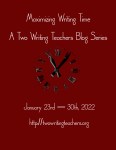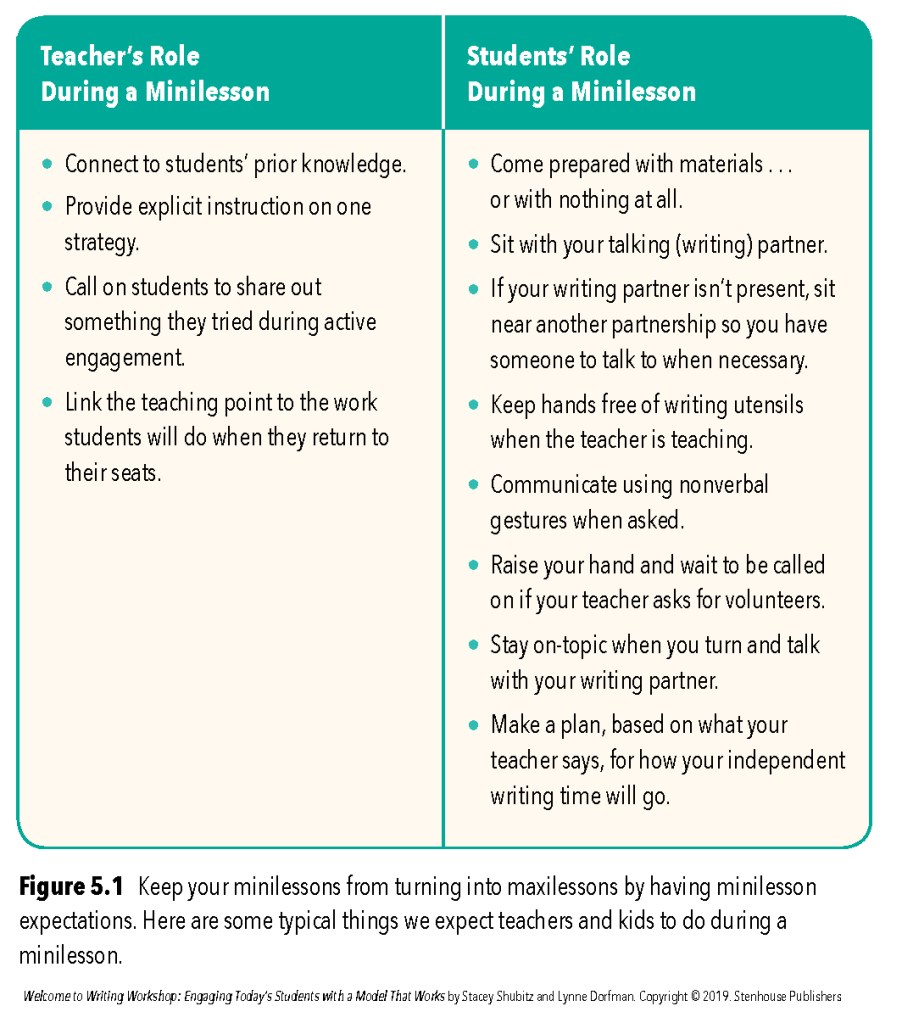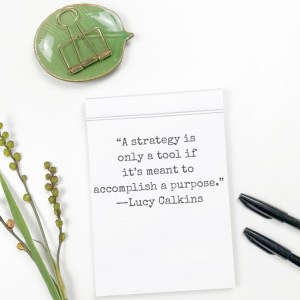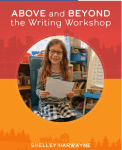Let me tell you about my early years as a classroom teacher. While I delivered many well-executed minilessons, there were times when my minilessons turned into maxilessons. If I’m being totally honest, I recall a few mini-lectures that I still cringe about to this day. As I grew in experience as a workshop teacher, I came to realize that teaching too much and for too long stole time from independent writing time, which meant my students didn’t write enough. And, in the spirit of full disclosure, this also meant that some end-of-workshop shares got eradicated since time for writing workshop ran out. 😬 With practice, I learned how to keep my whole-class instruction succinct, engaging, and short so I could target the needs of my students when I conferred and led small groups.
Why are minilessons short?
Minilessons are supposed to be mini to allow ample time for the heart of the workshop to occur. The heart of the workshop is independent writing time when the teacher is conferring and meeting with small groups. Minilessons are short, explicit lessons taught at the beginning of a writing workshop session to teach students one new strategy while giving them some time to practice that strategy before transitioning to independent writing.
According to my colleague Beth Moore, “Minilessons are also short because the short format makes them more engaging – kids become accustomed that the teaching point will come quickly and explicitly and they’ll be asked to do something and go…. they are also short because it is whole class instruction that keeps a unit of study moving, but really it is the conferring and small group work where students’ needs are met – not the minilesson. The minilesson becomes a familiar experience, a menu item, or option that can be referred to or selected when a kid needs it – but it’s optional. Conferring on the other hand is tailored specifically to the kid – not really optional.”
Create a List
Make sure students come prepared to the meeting area with everything they’ll need for the minilesson. It helps to provide students with a visual and an auditory reminder of what they’ll need to bring. So as to keep everyone in the meeting area, keep extra writing utensils and paper nearby in case someone forgets something. This minimizes disruptions so that time in the meeting area is focused on the minilesson.
For teachers who aren’t using a meeting area due to ongoing social distancing protocols, then there’s still a way to prepare kids while they sit at their desks. They can have just the items they need out on top of their desks while everything else they do not need gets stored away.
Know Your Roles
After observing in classrooms where minilessons ran too long, taught multiple strategies, left many students uncertain of how to implement the strategy in their own writing, or had students interrupting the lesson, I came to realize that it helps for students and teachers to understand their roles in a minilesson.
Pace Yourself
I’ve only taught writing using a writing workshop approach so I know no other way of doing things. That said, when I began teaching, my minilessons weren’t always mini. Pat Werner, my first literacy coach, encouraged me to keep a stopwatch beside me when I taught. She suggested a stopwatch, rather than a timer, so that I could pace myself through all parts of the minilesson. (If I were to use a timer, then it would cut me off at ten minutes, not giving me the valuable data I would’ve needed to know if a part of my minilesson went too long.)
A typical minilesson, that teaches using a demonstration or an explanation with example, has four distinct components:
| Connection | 1 – 2 minutes | Activates the students’ prior knowledge by connecting what they’re going to learn to previous lessons. |
| Teach | 3 – 6 minutes | Teaches students ONE new strategy* to help them become a better writer. |
| Active Engagement | 3 – 6 minutes | Provides students with time to try out the strategy in their own writing or with a partner. |
| Link | 1 – 2 minutes | Reminds students of the strategy they learned and how it connects to the ongoing work of the writer’s in the classroom and their growing repertoire of writing skills. |
Have a Clear Teaching Point
Begin every teaching point by saying “Today you will learn how to…” Being clear about what it is you’re about to teach helps students focus on the strategy they’re about to learn. After reading DIY Literacy: Teaching Tools for Differentiation, Rigor, and Independence by Kate Roberts and Maggie Beattie Roberts, I made sure that every teaching point had a clear WHAT (i.e., the thing you want students to do by the end of the minilesson), a clear HOW (i.e., the way students will carry out the skill) and a clear WHY (i.e., so students understand the purpose of the strategy). Being clear about what one is teaching helps the rest of a minilesson flow more smoothly since it tightens up the time it takes to teach a strategy and increases student engagement.
Keep It Matchy-Matchy
After you’ve had the chance to teach students how to execute a strategy during the “teaching” part of the minilesson, you’ll invite them to try out the same strategy in their own writing, together as a class with a piece of shared writing, or by working with their writing partner. The active engagement should match the demonstration so that you’re setting students up for success.
Refrain from Excessive Audience Participation
When I began teaching in 2004, the only time students were invited to participate in a minilesson was during the active engagement. Over time, teachers began to invite a lean amount of student participation during the connection. By involving students in a small way (e.g., thumbs up/thumbs down, brief turn & talk with a writing partner), students became more engaged and there was a bit of socialness added to minilessons. However, this does not mean that everyone is invited to speak or that you need to call on kids whose hands are raised.
Should the need arise for a whole-class conversation, then consider using the END of the workshop’s share session to address the issue at hand with the entire class rather than having the conversation take up the workshop time.
Wrapping It Up with a Bow
One of the best ways to maximize time in your writing workshop is to keep minilessons short. Not every minilesson has to be ten minutes. Sometimes they’ll be shorter. Occasionally, they’ll run a bit longer. However, keeping minilessons succinct, engaging, and brief is one of the best ways to maximize time since it never feels as though we have enough of it.
Further Reading
Through the years, we’ve written a lot about minilessons. Here are some of the pieces on minilessons I most often share with teachers when I’m consulting:
• A Short and Sweet Minilesson Formula
• How to Plan a Minilesson from Scratch
• Inquiry Minilessons: Beyond the Fundamentals of Writing Workshop
• Instant Minilesson Follow-Up
• Minilessons: It’s All About the Link
• Minilessons: Writing Workshop Fundamentals
• Quick Tips for Writing Teaching Points
• Showing, Not Telling: Demonstrations Matter
• Teach Kids How to Teach Minilessons
• The Importance of Repertoire for Teachers
• There Are More Ways Than One to Teach a Minilesson
• Top Ten Ways to Keep Minilessons from Turning into Maxilessons
Giveaway Info:
- This giveaway is for a copy of Above and Beyond the Writing Workshop by Shelley Harwayne. Many thanks to Stenhouse Publishers for donating a copy for one reader.
- For a chance to win this copy of Above and Beyond the Writing Workshop, please leave a comment about this post by Friday, January 28th at 11:59 a.m. EST. I will use a random number generator to pick the winner, whose name she will announce in a post recapping this blog series on January 30th. Eligible to be shipped to the USA and Canada.
- Please be sure to leave a valid e-mail address when you post your comment, so I can contact you to obtain your mailing address if you win.
- If you are the winner of the book, Stacey will email you with the subject line of TWO WRITING TEACHERS – MAXIMIZING WRITING TIME. Please respond to my e-mail with your mailing address within five days of receipt. A new winner will be chosen if a response isn’t received within five days of the giveaway announcement.






What a thoughtful and helpful post. I am a former principal, and I am now working as an instructional coach. I find that many teachers struggle to keep their mini lessons mini while also making the teaching point clear. This post serves as a great reminder about both points. You provide many structures to help teachers accomplish these goals. I am sharing this post with my coachees. Thank you! Shelley
LikeLike
Thank you for the chart that defines roles for the teacher and the students. I find that a minilesson on our roles can be a helpful way to give clarity to students around their responsilbities at the beginning of the year. And thank you for the reminder that we don’t have to call on every student who raises their hand. That’s something I don’t always remember to mention to new teachers.
LikeLike
This is a great reminder for us to keep mini lessons mini! I appreciate the conferring chart. Very helpful!
LikeLiked by 1 person
Incredibly useful refresher/instruction/inspiration. I will be using these posts all week in conversations with teachers! Thank you for the work you all do to help us support writers!
LikeLike
Always so helpful to reivisit the expectations of a mini-lesson.
LikeLiked by 1 person
Great tips! Writing workshop has been the focus of our CCC’s this year and it is my growth goal for the year. This article came right on time.
LikeLiked by 1 person
This is a great article to share with the staff. Quick tips and reminders, especially for our newer teachers who have been growing so much in their craft. I couldn’t be prouder of them. Thank you for sharing this with us. Much appreciated!
LikeLiked by 1 person
Great reminders and excellent resources to support writing teachers!
LikeLiked by 1 person
Wonderful post. I especially like the point you made about making sure the teaching point includes a clear what, how, and why. When the teaching point is clear and fully understood, the minilesson will be effective.
LikeLiked by 1 person
Thank you for this great post, Stacey. I’ve been leading paraeducators/teaching assistants in a series of workshops this school year. The series has focused on how to support students during reading and writing workshop. I’ve used Welcome to Writing Workshop and Craft Moves as two incredibly valuable resources for the series. Kudos to you and your TWT for always providing content that teachers can use immediately, you’re all a gift to students and educators.❤️
LikeLike
Hi Kathy!
We workshop every series we do as a team. As always, I’m so proud of this one. All of the pieces provide lots of excellent tips and tricks for maximizing time.
Be well and stay warm up there!
LikeLike
As a coach, this was very helpful. I’ll be sharing with my teachers.
LikeLiked by 1 person